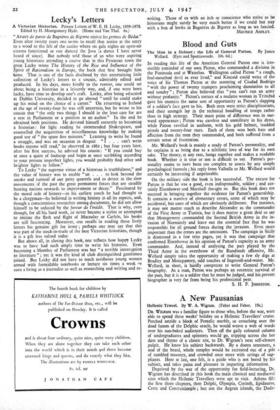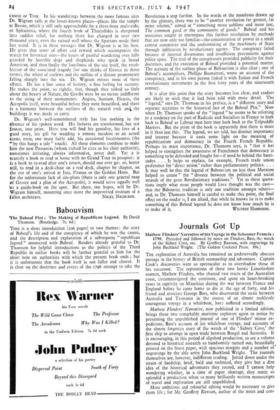A New Pausanias
Hellenic TraveL By W. A. Wigram. (Faber and Faber. 15s.)
DR. WIGRAM was a familiar figure to those who, before the war, were able to spend three weeks' holiday on a Hellenic Travellers' cruise. Perched astride a block of Pentelic marble, or crouching over the dead fumes of the Delphic oracle, he would weave a web of words over his sun-baked audiences. Then off the gaily coloured column of undergraduates and spinsters would go, tripping across the hot dust and thyme of a classic site, to Dr. Wigram's next self-chosen pulpit. He knew his subject backwards. By a dozen sentences, a nod of the beard, whole temples would be recreated out of a pile of tumbled masonry, and crowded once more with strings of sup- pliants. Here at last, one felt, is a guide who is not bored by his subject, and takes pains and pleasure in imparting information.
Deprived by the war of the opportunity for field-lecturing, Dr. Wigram has described in this book the main classical and mediaeval sites which the Hellenic Travellers were apt to visit. Athens fills the first three chapters, then Delphi, Olympia, Corinth, Epidauros, Crete and Constantinople but not the Aegean islands, the Dode-
canese or Troy. In his wanderings between the more famous sites Dr. Wigram calls at the lesser-known places—places like the temple at Bassae, which is still only approachable by a three-hour mule-ride, or Sphacteria, where the fourth book of Thucydides is sharpened into sudden relief, for nothing there has changed in over two thousand years, even the ruined wall where the Spartans made their last stand. It is in these passages that Dr. Wigram is at his best. He gives that sense of effort and reward which accompanies the search for historical sites--the hours of painful wandering over hills guarded by horrible dogs and shepherds who speak in broad American, and then finally the loneliness of the site itself, the recol- lection of the associated tragedy (for one thinks of Greece in those terms), the wheel of curlews and the outline of a distant promontory falling sharply into the sea. Dr. Wigram misses none of these effects. He has a fine sense of history, a fine feeling for scenery. He makes the point, so rightly, that, though they talked so little about the beauty of Nature, the Greeks were by no means indifferent to the siting of their monuments. Aegina, Sunium, Eleusis, the Acropolis itself, were beautiful before they were beautified, and there is a harmony between the outlines of the natural rock and, the buildings it was made to carry.
Dr. Wigram's well-remembered style has lost nothing in the absence of his spoken word. His lectures are transformed, but not frozen, into print. Here you will find his geniality, his love of a good story, his gift for wedding a remote incident .to an actual scene, even, one must fairly add, his occasional facetiousness (the "by this hangs a tale " touch). All these elements combine to make him the new Pausanias (whom indeed he cites as his chief authority), sometimes irritating, always informative, never dull. Yet it is scarcely a book to read at home with no Grand Tour in prospect: it is a book to re-read after one's return, should one ever go: or, better still, to read in a deck-chair on a real deck, chapter by chapter, on the eve of one's arrival at Itea, Piraeus or the Golden Horn. But for the unfortunate lack of site-plans (there is only one general map of Greece and a plan of the Acropolis), it would serve equally well las a guide-book on the spot. But there, one hopes, will be Dr. Wigram himself, mounting once more the improvised rostrum of a







































 Previous page
Previous page